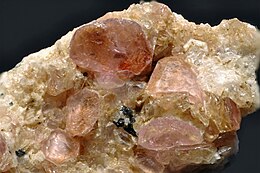
Back Pezzottaïta Catalan Pezzottait Czech Pezzottaíta Spanish Pezzottaita EU Pezzottaïte French Pezotait ID Pezzottaite Italian ペツォッタイト Japanese Pezzotaiet Dutch Pezzottait Polish
This article includes a list of references, related reading, or external links, but its sources remain unclear because it lacks inline citations. (August 2021) |
| Pezzottaite | |
|---|---|
 | |
| General | |
| Category | Cyclosilicate minerals |
| Formula (repeating unit) | Cs(Be2Li)Al2Si6O18 |
| IMA symbol | Pez[1] |
| Crystal system | Trigonal |
| Crystal class | Ditrigonal pyramidal (3m) (same H-M symbol) |
| Space group | R3c |
| Identification | |
| Color | Raspberry red, orange-red, pink |
| Crystal habit | flattened, tabular, equant, aggregate |
| Cleavage | Imperfect; basal |
| Fracture | Conchoidal to uneven |
| Tenacity | brittle |
| Mohs scale hardness | 8 |
| Luster | Vitreous |
| Streak | White |
| Specific gravity | 3.10 |
| Optical properties | uniaxial |
| Refractive index | 1.601 to 1.620 |
| Birefringence | −0.008 to 0.011 |
| Pleochroism | Moderate dichroic |
| References | [2][3][4] |
Pezzottaite, marketed under the name raspberyl or raspberry beryl, is a mineral species first recognized by the International Mineralogical Association in September 2003. Pezzottaite is a caesium analogue of beryl, a silicate of caesium, beryllium, lithium and aluminium, with the chemical formula Cs(Be2Li)Al2Si6O18. Named after Italian geologist and mineralogist Federico Pezzotta, pezzottaite was first thought to be either red beryl or a new variety of beryl ("caesium beryl"); unlike actual beryl, however, pezzottaite contains lithium and crystallizes in the trigonal crystal system rather than the hexagonal system.
- ^ Warr, L.N. (2021). "IMA–CNMNC approved mineral symbols". Mineralogical Magazine. 85 (3): 291–320. Bibcode:2021MinM...85..291W. doi:10.1180/mgm.2021.43. S2CID 235729616.
- ^ Mineralienatlas
- ^ Mindat.org: Pezzottaite
- ^ Webmineral.com